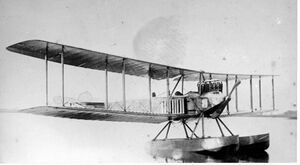Engineering:Hansa-Brandenburg W
From HandWiki
This article includes a list of references, related reading or external links, but its sources remain unclear because it lacks inline citations. (January 2024) (Learn how and when to remove this template message) |
| W, NW, and GNW | |
|---|---|

| |
| Role | Reconnaissance seaplane |
| National origin | Germany |
| Manufacturer | Hansa-Brandenburg |
| First flight | 1914 |
| Primary user | Imperial German Navy |
| Number built | 77 |
The Hansa-Brandenburg W was a reconnaissance floatplane produced in Germany in 1914 to equip the Imperial German Navy. Similar in general layout to the Hansa-Brandenburg B.I landplane, the W was a conventional three-bay biplane with unstaggered wings of equal span. The pilot and observer sat in tandem, open cockpits, and the undercarriage consisted of twin pontoons.
The NW and GNW of 1915 were a revised versions powered by a more powerful engine.
Variants
- W - initial production version with Benz Bz.II engine (27 built)
- NW - revised version with Mercedes D.III engine
- GNW - revised version with Mercedes D.III engine
Operators
 Germany
Germany
- Kaiserliche Marine
- Ottoman Air Force [citation needed]
Specifications (NW)
General characteristics
- Crew: Two, pilot and observer
- Length: 9.40 m (30 ft 10 in)
- Wingspan: 16.50 m (54 ft 2 in)
- Gross weight: 1,650 kg (3,640 lb)
- Powerplant: 1 × Mercedes D.III , 120 kW (160 hp)
Performance
- Maximum speed: 90 km/h (56 mph, 49 kn)
- Range: 320 km (200 mi, 170 nmi)
References
- Nelcarz, Bartolomiej; Peczkowski, Robert (2001). White Eagles: The Aircraft, Men and Operations of the Polish Air Force 1918–1939. Ottringham, UK: Hikoki Publications. ISBN 1-902109-73-2.
- Owers, Colin A. (2015). Hansa-Brandenburg Aircraft of WWI: Volume 2–Biplane Seaplanes. Great War Aviation Centennial Series. 18. n.p.: Aeronaut Books. ISBN 978-1-935881-32-2.
 |

